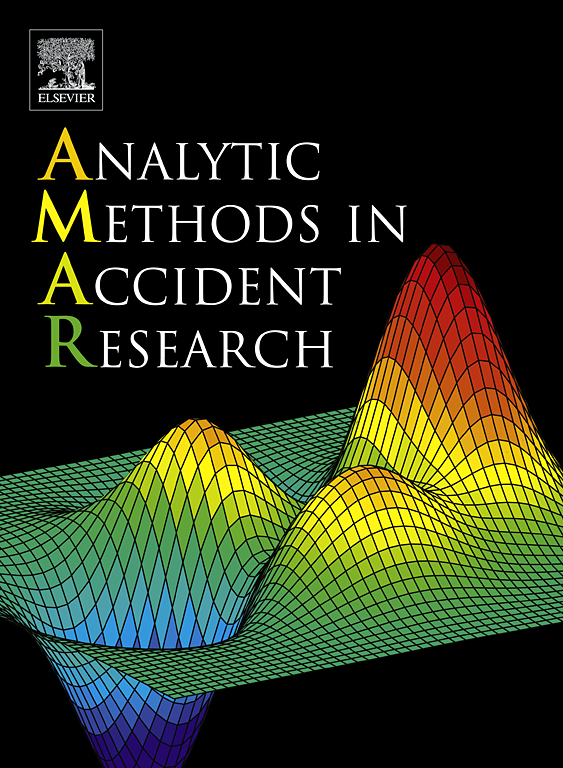A unified probabilistic approach to traffic conflict detection
IF 12.6
1区 工程技术
Q1 PUBLIC, ENVIRONMENTAL & OCCUPATIONAL HEALTH
引用次数: 0
Abstract
Traffic conflict detection is essential for proactive road safety by identifying potential collisions before they occur. Existing methods rely on surrogate safety measures tailored to specific interactions (e.g., car-following, side-swiping, or path-crossing) and require varying thresholds in different traffic conditions. This variation leads to inconsistencies and limited adaptability of conflict detection in evolving traffic environments, particularly as the integration of autonomous driving systems adds complexity. Consequently, there is an increasing need for consistent detection of traffic conflicts across interaction contexts. To address this need, we propose a unified probabilistic approach in this study. The proposed approach establishes a unified framework of traffic conflict detection, where traffic conflicts are formulated as context-dependent extreme events of road user interactions. The detection of conflicts is then decomposed into a series of statistical learning tasks: representing interaction contexts, inferring proximity distributions, and assessing extreme collision risk. The unified formulation accommodates diverse hypotheses of traffic conflicts and the learning tasks enable data-driven analysis of factors such as motion states of road users, environment conditions, and participant characteristics. Jointly, this approach supports consistent and comprehensive evaluation of the collision risk emerging in road user interactions. We demonstrate the proposed approach by experiments using real-world trajectory data. A unified metric for indicating conflicts is first trained with lane-change interactions on German highways, and then compared with existing metrics using near-crash events from the U.S. 100-Car Naturalistic Driving Study. Our results show that the unified metric provides effective collision warnings, generalises across distinct datasets and traffic environments, covers a broad range of conflict types, and captures a long-tailed distribution of conflict intensity. In summary, this study provides an explainable and generalisable approach that enables traffic conflict detection across varying interaction contexts. The findings highlight its potential to enhance the safety assessment of traffic infrastructures and policies, improve collision warning systems for autonomous driving, and deepen the understanding of road user behaviour in safety–critical interactions.
交通冲突检测的统一概率方法
交通冲突检测通过在潜在的碰撞发生之前识别出潜在的碰撞,对积极的道路安全至关重要。现有的方法依赖于为特定的相互作用量身定制的替代安全措施(例如,汽车跟随、侧身滑动或过马路),并且在不同的交通条件下需要不同的阈值。这种变化导致了冲突检测在不断变化的交通环境中的不一致性和有限的适应性,特别是在自动驾驶系统的集成增加了复杂性的情况下。因此,越来越需要跨交互上下文一致地检测流量冲突。为了满足这一需求,我们在本研究中提出了一种统一的概率方法。该方法建立了一个统一的交通冲突检测框架,其中交通冲突被表述为道路使用者交互的上下文相关的极端事件。然后将冲突检测分解为一系列统计学习任务:表示交互上下文、推断接近分布和评估极端冲突风险。统一的公式可以容纳交通冲突的多种假设,学习任务可以对道路使用者的运动状态、环境条件和参与者特征等因素进行数据驱动分析。总之,该方法支持对道路使用者互动中出现的碰撞风险进行一致和全面的评估。我们通过使用真实世界轨迹数据的实验证明了所提出的方法。首先用德国高速公路上的变道相互作用来训练指示冲突的统一度量,然后用美国100辆汽车自然驾驶研究中的近碰撞事件与现有度量进行比较。我们的研究结果表明,统一的度量提供了有效的碰撞警告,概括了不同的数据集和交通环境,涵盖了广泛的冲突类型,并捕获了冲突强度的长尾分布。总之,本研究提供了一种可解释和可推广的方法,可以在不同的交互环境中进行流量冲突检测。研究结果强调了它在加强交通基础设施和政策的安全评估、改进自动驾驶的碰撞预警系统以及加深对安全关键互动中道路用户行为的理解方面的潜力。
本文章由计算机程序翻译,如有差异,请以英文原文为准。
求助全文
约1分钟内获得全文
求助全文
来源期刊

Analytic Methods in Accident Research
Multiple-
CiteScore
22.10
自引率
34.10%
发文量
35
审稿时长
24 days
期刊介绍:
Analytic Methods in Accident Research is a journal that publishes articles related to the development and application of advanced statistical and econometric methods in studying vehicle crashes and other accidents. The journal aims to demonstrate how these innovative approaches can provide new insights into the factors influencing the occurrence and severity of accidents, thereby offering guidance for implementing appropriate preventive measures. While the journal primarily focuses on the analytic approach, it also accepts articles covering various aspects of transportation safety (such as road, pedestrian, air, rail, and water safety), construction safety, and other areas where human behavior, machine failures, or system failures lead to property damage or bodily harm.
 求助内容:
求助内容: 应助结果提醒方式:
应助结果提醒方式:


